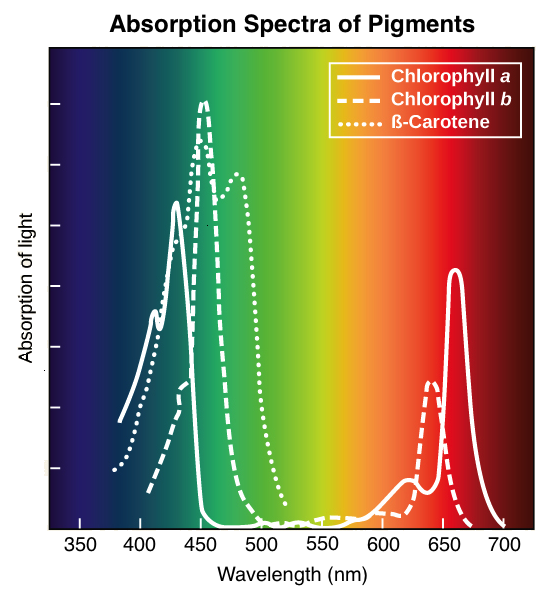Explain Why Plants Absorb Different Wavelengths of Light
Green is typically not absorbed which is why plants appear green meaning photosynthetic rates are low under this condition. The green pigment involved in photosynthesis is chlorophyll.

Wavelengths Of Light And Photosynthetic Pigments Article Khan Academy
White pigments reflect most of the wavelengths striking them.
. These pigment molecules mainly absorb red and blue wavelengths meaning photosynthesis occurs at a higher rate at these wavelengths. The relative absorption of different wavelengths of light by a pigment is represented by an absorption spectrum. Different kinds of pigments exist and each absorbs only certain wavelengths colors of visible light.
All photosynthetic organisms contain a pigment called chlorophyll a which humans see as the common green color associated with plants. Plants also contain in fewer numbers carotenoid pigments which absorb light mostly in the purpleblue. Plants absorb both red and purple light waves however because purple wavelengths are shorter they contain more energy.
The set of wavelengths that a pigment doesnt absorb are reflected and the reflected light is what we see as color. Chlorophyll a the primary pigment of most plants appears green. A pigment is a substance that reflects some wavelengths of visible light while absorbing others.
Chlorophyll in plants is present in two varieties chlorophyll a and chlorophyll b. Carotenoids absorb in the short-wavelength blue region and reflect the. This is why plants are green-- chlorophyll absorbs violetred and blueorange light but reflects green light.
Other pigments that plants have in their leaves absorb light of different colors so they reflect red orange yellow or blue light and appear to be those colors to our eyes. Chlorophyll the green pigment common to all photosynthetic cells absorbs all wavelengths of visible light except green which it reflects. The other bands of light pass through unaffected or are reflected giving the characteristic green color to the leaves.
Chlorophyll a absorbs wavelengths from either end of the visible spectrum blue and red but not green. Chlorophyll a absorbs wavelengths from either end of the visible. All photosynthetic organisms contain a pigment called chlorophyll a which humans see as the common green color associated with plants.
Chlorophyll just absorbs blue and red light. Pigments absorb light energy at certain wavelengthes and reflect the light they dont absorb. The set of wavelengths absorbed by a pigment is its absorption spectrum.
In this exercise you will plot an absorption spectrum for the spinach leaf pigments that are available. White pigments reflect most of the wavelengths striking them. Black leaves likely overheat more than green leaves.
For example blue light has a lot of energy think UV and sunburns while red light has lower energy infraredheat waves. This is where plant phytochromes absorb to sense redfarred intensity. Pigments reflect the color of the wavelengths that they cannot absorb.
The color of the pigment corresponds to the wavelength of light it reflects. Because green is reflected or transmitted chlorophyll appears green. Chlorophyll the green pigment common to all photosynthetic cells absorbs all wavelengths of visible light except green which it reflects.
Also absorbing different wavelengths depends on the pigment molecules in the plant and how much energy can be harvested from that wavelength. It is the reflection of the green light that reaches out eyes giving chlorophyll. Thus green wavelengths are often the most common light in deep water.
This causes an absorption of energy from red and blue wavelengths which is used in photosynthesis. Blue wavelengths are more readily absorbed if the water contains average or abundant amounts of organic material. Light because chlorophyll a and b as well as several types of carotenoids are present in the spinach.
This is why plants appear green to us. If white light is shone on an orange filter only the orange wavelengths will be observed by the human eye. This is why plants appear green to us.
Absorption of light by plants between the wavelength 750 - 850 nm is important. Black pigments absorb all wavelengths of visible light that strike them. Different kinds of pigments exist and each absorbs only certain wavelengths colors of visible light.
For instance plants appear green to us because they contain many chlorophyll a and b molecules which reflect green light. Coloured objects in coloured light An object appears to be black if it absorbs all the. Light is absorbed by various pigments in the leaf mainly chlorophyll.
Visible light falls between 400 and 700 nanometers. It hardly absorbs any green light at all so the green gets reflected back to our eyes which is why leaves appear green. Chlorophyll is green in appearance because it absorbs red and blue light making these colours unable to be seen.
Chlorophylls absorb red and blue wavelengths much more strongly than they absorb green wavelengths which is why chlorophyll-bearing plants appear green. The green pigment chlorophyll restricts the efficiency of photosynthesis. This was supported by our experiment because red.
Pigments reflect the color of the wavelengths that they cannot absorb. Black pigments absorb all wavelengths of visible light that strike them.
Do Plant Absorbs Blue Colour Light During Photosynthesis Quora
Introduction To Photosynthesis

Optics How Do Plants Absorb Different Rates Of Light Physics Stack Exchange

Wavelengths Of Light And Photosynthetic Pigments Article Khan Academy
No comments for "Explain Why Plants Absorb Different Wavelengths of Light"
Post a Comment